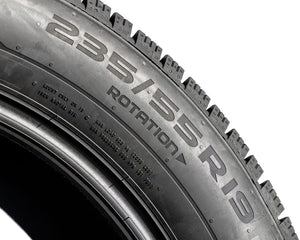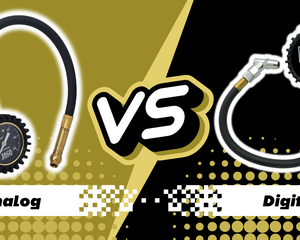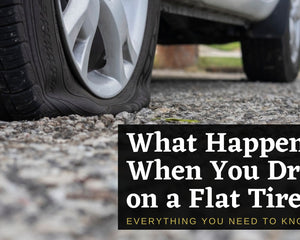
When it comes to vehicle maintenance, tires often don't get the attention they deserve. Yet, these rounds of rubber play a pivotal role in your vehicle's performance, particularly in terms of safety and efficiency. Among the aspects of tire care, tire pressure is paramount. It's more than just numbers on a gauge; it's a determinant of how your vehicle interacts with the road.
With modern advancements, vehicles have become more robust, and tires more enduring. However, this progression should not invite complacency when it comes to tire upkeep. Tire pressure monitoring systems, compulsory on all new vehicles since 2008, are indeed a step forward, but they're not an excuse to set aside regular manual checks.
This brings us to the focal point of our discussion - How does tire pressure affect a vehicle's braking distance? This underexplored question bears significant implications for road safety. By understanding the dynamics between tire pressure and braking distance, we can further appreciate the importance of maintaining the right tire pressure. Let's delve deeper into this topic and shed light on the intricate interplay of tire pressure and braking performance.
Understanding Tire Pressure
Before we dive into the specifics of how tire pressure affects braking distance, it's crucial to comprehend the concept of tire pressure. So, let's take a look at what tire pressure is and its significance.
What is Tire Pressure?
Tire pressure, denoted in pounds per square inch (PSI), measures the amount of air in your vehicle's tires. It's a key factor affecting your vehicle's overall performance and safety.
The Importance of Proper Tire Pressure
Maintaining the right tire pressure is integral to your vehicle's grip, control, and fuel efficiency. Correctly inflated tires can evenly distribute your vehicle's weight across the tire's footprint, leading to uniform tire wear and longer tire life.
Common Mistakes Regarding Tire Pressure
Despite the clear importance of maintaining proper tire pressure, many vehicle owners make critical errors. Let's review some of these common mistakes:
Waiting Until There's an Obvious Problem
Waiting until your tire appears visibly deflated is risky. The difference between a properly inflated tire and an underinflated one can be as minor as 5 PSI - a detail not easily detected through a visual check.
Relying Solely on Tire Pressure Monitoring Systems
While these systems are useful for alerting you of significant pressure loss, they are not always accurate. They often allow a broad range of pressures that may not be optimal for your tires. Regular manual checks with a trusted tire pressure gauge are recommended.
Overinflating Tires for Better Fuel Efficiency
Yes, underinflated tires can reduce your vehicle's fuel efficiency, but overinflating isn't the answer. Overinflated tires make less contact with the road, compromising your vehicle's traction and, consequently, safety.
By avoiding these common missteps, you can ensure optimal tire pressure management, enhancing your vehicle's performance and safety on the road.

The Relationship between Tire Pressure and Vehicle Handling
One often overlooked aspect of driving safety and performance is the relationship between tire pressure and vehicle handling. How your car responds to steering, braking, and overall control is significantly influenced by tire pressure.
How Does Tire Pressure Affect Vehicle Handling?
Proper tire pressure impacts vehicle handling by ensuring maximum tread contact with the road. This effect results in more control and stability, especially when turning or driving at high speeds.
Overinflated tires, conversely, have less contact with the road due to their rounded profile, leading to reduced traction. They may feel more responsive due to the increased hardness, but in reality, the reduced contact area compromises control.
Underinflated tires have a different problem. They flex more, leading to increased tire wear and heat buildup. This condition can result in unpredictable handling and even tire failure.
The Link between Tire Pressure and Braking Distance
The balance between your car and the road is most crucial when it comes to stopping in time to avoid a collision. This is where tire pressure and braking distance share a direct relationship.
When your tires are properly inflated, they provide optimal contact with the road and evenly distribute the force applied during braking. This efficiency allows your vehicle to stop in the shortest possible distance.
However, both overinflation and underinflation can lengthen your braking distance. Overinflated tires, with less tread contact, take longer to stop, while underinflated tires, with increased resistance, can do the same. This critical information underscores the importance of maintaining the correct tire pressure for vehicle safety.

Impact of Overinflation on Braking Distance
Understanding Overinflation
Overinflation refers to the condition when a tire is filled with air beyond the recommended PSI (Pounds per Square Inch). While some drivers believe overinflation can increase fuel efficiency or tire lifespan, the risks associated with this practice significantly outweigh any potential benefits.
How Overinflated Tires Affect Braking Distance
When a tire is overinflated, the tire's center bulges out, reducing the tire tread's contact with the road. This reduced surface area results in less friction and thus less stopping power. Consequently, overinflated tires can lead to an increased braking distance, potentially putting the driver and passengers in danger during abrupt stops.
Risks Associated with Overinflated Tires
Besides the extended braking distance, overinflated tires also present other risks. The increased tire pressure can cause tires to be more susceptible to punctures and blowouts. Furthermore, overinflation can lead to uneven tire wear, resulting in decreased overall tire life. Lastly, overinflated tires can make for a bumpier ride as they absorb less shock from the road.
Impact of Underinflation on Braking Distance
Understanding Underinflation
Underinflation is when a tire has less than the recommended amount of air pressure. It's a common issue that can arise from simple neglect, slow leaks, or changes in temperature. Despite being a frequent occurrence, underinflation can have severe effects on a vehicle's performance and safety.
How Underinflated Tires Affect Braking Distance
Underinflated tires have more tire surface making contact with the road. While this might sound beneficial, it's not. The increased contact area creates more friction, which rather than aiding braking, makes the tires work harder, resulting in more heat and faster wear. This condition can significantly increase the braking distance, especially at higher speeds.
Risks Associated with Underinflated Tires
Aside from increased braking distance, underinflated tires pose several other risks. They wear out faster, particularly on the edges where the extra flex occurs. They also generate more heat, which can lead to tire blowouts. Additionally, underinflated tires negatively affect fuel efficiency, forcing the vehicle to consume more fuel. Therefore, keeping your tires at the correct inflation level is vital for optimal vehicle performance and safety.

The Science Behind Tire Pressure and Braking Distance
Physics Involved in Braking and Tire Pressure
Understanding the science behind tire pressure and braking distance involves some basic physics. When you apply the brakes, the kinetic energy of the moving vehicle is converted into heat by the friction between the tires and the road surface. The larger the contact area between the tire and the road (the "contact patch"), the more friction is created, and the quicker the vehicle can stop. However, the right amount of contact area is crucial. Overinflated tires have less contact area due to the tire's center bulge, whereas underinflated tires create excessive friction that can lead to overheating and increased tire wear.
Why Proper Tire Pressure Leads to Optimal Braking Distance
Proper tire pressure ensures that the tire's contact patch with the road is optimal, maximizing the friction required for braking while preventing excessive friction that can lead to overheating and wear. Hence, maintaining the right tire pressure ensures a consistent and reliable braking distance, contributing to overall vehicle safety.
Tips for Maintaining Proper Tire Pressure
Frequency of Checking Tire Pressure
It's recommended to check your tire pressure at least once a month and before long trips. Regular checks are essential as tire pressure can change with temperature fluctuations and normal seepage. Remember, a tire can lose up to half of its inflation pressure and not appear to be flat!
How to Check Tire Pressure
Checking tire pressure is a straightforward task. All you need is a tire pressure gauge. Ensure your tires are 'cold' - meaning they haven't been driven on for at least three hours. Insert the pressure gauge into the valve stem on your tire, the gauge will then provide a PSI reading. Compare this with the manufacturer's recommended PSI (often found in your vehicle's owner manual or the driver's side door jamb).
What to Do When Tire Pressure is Not at the Recommended Level
If your tire pressure is not at the recommended level, you should adjust it immediately. If the pressure is too low, use an air compressor to inflate the tire to the correct pressure. If the pressure is too high, let some air out until it matches the recommended pressure. After adjusting, always recheck the pressure with your gauge. And remember, if you're continuously having to adjust your tire pressure, it's time to consult a professional as your tires could have a slow leak or another issue.
Final Thoughts
In our journey through the intricacies of tire pressure, we've discovered just how crucial this often overlooked aspect of vehicle maintenance truly is. The correct tire pressure significantly impacts a vehicle's braking distance. Overinflation reduces the tire's contact area with the road, leading to increased braking distance and risks like reduced grip and premature tire wear. Conversely, underinflation causes an excess contact area, resulting in increased friction, overheating, faster tire wear, and, again, longer braking distance.
Maintaining the correct tire pressure goes beyond just ensuring optimal braking distance. It contributes to overall vehicle handling, tire longevity, and fuel efficiency. Ignoring tire pressure could lead not just to sub-optimal performance but potential safety risks as well.
What You Can Do

With the insights provided in this post, you're now armed with the knowledge to ensure your vehicle's safety and optimum performance. However, knowledge must be paired with action. Regularly checking your tire pressure with quality tools, such as tire gauges and tire inflators, at least once a month and before long trips, is a small task with significant benefits.
If your tire pressure is not at the recommended level, take immediate steps to correct it. And remember, if you're consistently losing tire pressure, it may be time to visit a professional. Stay safe, optimize your vehicle's performance, and ensure the longevity of your tires by keeping that tire pressure in check!




